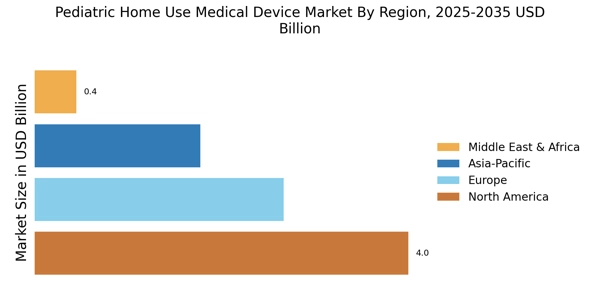Increased Investment in Pediatric Healthcare
The Pediatric Home Use Medical Device Market is witnessing increased investment from both public and private sectors aimed at improving pediatric healthcare. Governments and healthcare organizations are allocating more resources to develop and promote home-use medical devices tailored for children. This investment is often driven by the recognition of the unique healthcare needs of pediatric patients and the potential for home-based solutions to alleviate pressure on healthcare systems. Furthermore, partnerships between technology companies and healthcare providers are emerging, fostering innovation in device design and functionality. This influx of capital is likely to accelerate the development of new products, thereby expanding the market and enhancing the availability of effective home healthcare solutions for children.
Growing Awareness of Home Healthcare Benefits
The Pediatric Home Use Medical Device Market is benefiting from a growing awareness of the advantages associated with home healthcare. Parents and caregivers are increasingly recognizing that home-based medical devices can provide effective monitoring and treatment options, reducing the need for frequent hospital visits. This shift in perception is supported by studies indicating that home healthcare can lead to better health outcomes and increased patient satisfaction. As a result, the demand for pediatric home use devices is likely to rise, with an emphasis on products that are user-friendly and designed specifically for children. This trend is expected to contribute to a robust growth trajectory for the market in the coming years.
Rising Incidence of Pediatric Chronic Diseases
The Pediatric Home Use Medical Device Market is significantly influenced by the rising incidence of chronic diseases among children, such as asthma, diabetes, and obesity. According to recent health statistics, the prevalence of these conditions has been steadily increasing, necessitating ongoing management and monitoring. This trend has led to a heightened demand for home-use medical devices that facilitate regular health assessments and interventions. For example, devices that monitor blood glucose levels or asthma inhalers with integrated tracking systems are becoming essential tools for parents and caregivers. The market is expected to expand as healthcare providers increasingly recommend home-based solutions for managing these chronic conditions, thereby enhancing the quality of life for affected children.
Regulatory Support for Pediatric Home Use Devices
The Pediatric Home Use Medical Device Market is also benefiting from regulatory support aimed at facilitating the approval and adoption of home-use devices for children. Regulatory bodies are increasingly recognizing the importance of ensuring that medical devices are safe and effective for pediatric populations. This has led to streamlined approval processes and guidelines specifically tailored for pediatric devices. Such regulatory frameworks not only encourage innovation but also instill confidence among parents and healthcare providers regarding the use of these devices at home. As a result, the market is likely to see a rise in the introduction of new products that meet regulatory standards, further driving growth in the pediatric home use medical device sector.
Technological Innovations in Pediatric Home Use Medical Devices
The Pediatric Home Use Medical Device Market is experiencing a surge in technological innovations that enhance device functionality and user experience. Advancements in telemedicine, remote monitoring, and mobile health applications are transforming how pediatric care is delivered at home. For instance, devices equipped with artificial intelligence can analyze patient data in real-time, providing immediate feedback to caregivers. This trend is supported by a growing body of research indicating that technology can improve health outcomes for children with chronic conditions. As a result, the market is projected to grow at a compound annual growth rate of approximately 8% over the next five years, driven by the increasing demand for efficient and effective home care solutions.


















Leave a Comment